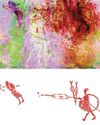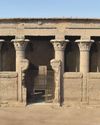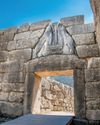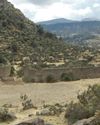One of Cappadocia’s underground cities may yet yield clues about its history.

The landscape of Cappadocia in central Turkey is dry and jagged and strange. Winding roads look out onto mountain peaks rising to almost 13,000 feet, and vast canyons and cliff faces have been striped dark brown, rusty red, and sandy yellow over the epochs. Pigeons, first introduced into the region by the Romans, wing by at eye level. Fantastical 40- to 50-foot-high “fairy chimneys”—spires of soft volcanic tuff—rise up from the desert floor. Carved into some of these hillsides are houses—some recently built and some centuries old—with rough wooden doors, small windows, and storage areas overhung by high shelves of stone. There are even rock-cut garages where drivers swoop into the dark and then cut their engines.
This picturesque region draws more than two million tourists a year, and everywhere there are road signs directing visitors to ancient settlements carved into the rock, such as Derinkuyu, a large underground city that plunges 280 feet into the earth. It dates to at least as far back as the Byzantine era, features stables, wineries, and churches, and may once have been home to tens of thousands of people. There is also Göreme, where an array of tombs and temples were carved directly into the hillside starting in the eleventh century a.d. Another of these sites, an impressive honeycomb of rooms intended as a year-round rock settlement, overlooks the modern downtown of the provincial capital of Nevsehir, or “New City.”
This story is from the March/April 2017 edition of Archaeology.
Start your 7-day Magzter GOLD free trial to access thousands of curated premium stories, and 8,500+ magazines and newspapers.
Already a subscriber ? Sign In
This story is from the March/April 2017 edition of Archaeology.
Start your 7-day Magzter GOLD free trial to access thousands of curated premium stories, and 8,500+ magazines and newspapers.
Already a subscriber? Sign In

A Very Close Encounter
New research has shown that human figures painted in red on a rock art panel in central Montana depict individuals engaged in a life-or-death encounter during an especially fraught historical moment.

A Sword for the Ages
A zigzag pattern, now tinged with the green-blue patina of oxidized metal, adorns the octagonal hilt of a rare sword dating to the Middle Bronze Age in Germany (1600-1200 B.C.) that was recently excavated in the Bavarian town of Nördlingen.

Ancient Egyptian Astrology
For centuries, layers of soot have coated the ceilings and columns in the entrance hall of Egypt's Temple of Esna. Now, an Egyptian-German team of researchers, led by Hisham El-Leithy of the Egyptian Ministry of Tourism and Antiquities and Christian Leitz of the University of Tübingen, is restoring the temple's vibrant painted reliefs to their original brilliance.

BRONZE AGE POWER PLAYERS
How Hittite kings forged diplomatic ties with a shadowy Greek city-state

RITES OF REBELLION
Archaeologists unearth evidence of a 500-year-old resistance movement high in the Andes

Secrets of Egypt's Golden Boy
CT scans offer researchers a virtual look deep inside a mummy's coffin

When Lions Were King
Across the ancient world, people adopted the big cats as sacred symbols of power and protection

UKRAINE'S LOST CAPITAL
In 1708, Peter the Great destroyed Baturyn, a bastion of Cossack independence and culture

LAPAKAHI VILLAGE, HAWAII
Standing beside a cove on the northwest coast of the island of Hawaii, the fishing village of Lapakahi, which is surrounded by black lava stone walls, was once home to generations of fishers and farmers known throughout the archipelago for their mastery of la'au lapa'au, or the practice of traditional Hawaiian medicine. \"

A MORE COMFORTABLE RIDE
Although the date is much debated, most scholars believe people 5,000 years ago. For thousands of years after that, they did so without saddles. \"In comparison with horse riding, the development of saddles began relatively late, when riders began to care more about comfort and safety in addition to the horse's health,\" says University of Zurich archaeologist Patrick Wertmann.